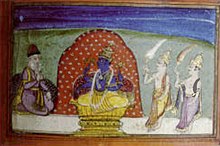Nirankar

| Part of a series on |
| Sikhism |
|---|
 |
Nirankar (Punjabi: ਨਿਰੰਕਾਰ, lit. 'formless'[1]) is one of the many attributes associated to God in Sikhism and means The Formless One.
Etymology
[edit]The word has its roots in the Sanskrit word nirākārā (Sanskrit: ਨਿਰਾਕਾਰਾ/निराकारा) and is a compound of two words: Nir meaning "without" and Akar (or Akaar), "shape" or "form"; hence, The Formless.[2]
Meaning and usage
[edit]The term is used as one of the names of God by Sikhs.[3]
It finds usage in the Guru Granth Sahib:
ਸਚ ਖੰਡਿ ਵਸੈ ਨਿਰੰਕਾਰੁ ॥
सच खंडि वसै निरंकारु ॥
Sacẖ kẖand vasai nirankār.
In the realm of Truth abides the Formless Lord.
— SGGS. Pg 8
Conjunction
[edit]The words is sometime conjoined with other terms. Some examples are below:
History
[edit]The term was first used to describe the divine by Guru Nanak.[1] The name later would become the namesake of the Nirankari sect founded by Baba Dayal Singh.[1]
References
[edit]- ^ a b c Nesbitt, Eleanor (2016). Sikhism: a very short introduction (2nd ed.). Oxford: Oxford University Press. p. 66. ISBN 978-0-19-874557-0.
- ^ "God in Sikhism 3". www.speakingtree.in. Retrieved 8 December 2017.
- ^ McLeod, William H., ed. (1990). Textual sources for the study of Sikhism. Textual sources for the study of religion. Chicago: Univ. of Chicago Press. p. 126. ISBN 978-0-226-56085-4.
- ^ a b Kumar, Nirmal (2006). Sikh Philosophy and Religion: 11th Guru Nanak Memorial Lectures. Guru Nanak memorial lecture series. Sterling Publishers Pvt. Ltd. p. 212. ISBN 9781932705683.
